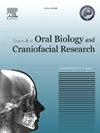Perspectives of laypeople towards the morphological characteristics of a youthful smile on frontal view: A computerized simulated photographic evaluation
Q1 Medicine
Journal of oral biology and craniofacial research
Pub Date : 2025-03-22
DOI:10.1016/j.jobcr.2025.03.008
引用次数: 0
Abstract
Background
The desire for a youthful smile is not limited by age, as individuals seek it throughout their lifetime. Aging affects the components of a smile; accordingly, this study assessed the perspectives of laypeople towards the morphological traits of a youthful smile on the frontal view. In this psychometric study, a 26-year-old female with a normal face, normal occlusion, teeth alignment, and no previous cosmetic surgery was employed as the photo model; sixteen smile images were obtained via Adobe Photoshop by varying incisal display, vertical step between maxillary central and lateral incisor, smile arch form, and buccal corridor size. The prepared photos were given to the layperson participants using an online questionnaire for age estimation.
Results
A total of 195 laypersons participated in the study. The results revealed that a 2 mm reduction, 4 mm increase, and 4 mm reduction in incisor display would increase the age estimation (P-Value<0.001). Futher, 1 mm reduction, a 0.5 mm reduction, and 0.5 mm increase in vertical step would contribute to overestimation of the age (P-Value<0.001). Additionally, the smile arc's reversed, straight, and moderate convexity increased the age estimation (P-Value<0.001). Regarding buccal corridor size, 1- and 2-mm reduction plus 2-mm increase resulted in age estimates significantly older than the original image (P-Value<0.001).
Conclusion
Perceptions of youthfulness are influenced by morphological traits such as incisor display, vertical step between central and lateral, smile arch form, and buccal corridor size.
外行人对正面年轻微笑形态特征的看法:计算机模拟照片评价
对青春微笑的渴望不受年龄的限制,因为每个人一生都在追求青春。年龄会影响微笑的成分;因此,本研究评估了外行人对年轻微笑的正面形态特征的看法。本心理测量学研究采用26岁女性,面部正常,咬合正常,牙齿排列正常,未做过整容手术;通过不同的切牙显示、上颌中切牙与侧切牙之间的垂直步距、微笑弓形和颊通道大小,通过Adobe Photoshop获得16张微笑图像。准备好的照片通过在线问卷的方式发给外行参与者进行年龄估计。结果共有195名外行人参与研究。结果显示,切牙显示减少2 mm、增加4 mm和减少4 mm会增加年龄估计(p值<;0.001)。此外,垂直步幅减小1 mm、减小0.5 mm和增大0.5 mm会导致年龄高估(p值<;0.001)。此外,微笑弧线的反、直和中等凸度增加了年龄估计(p值<;0.001)。关于颊道大小,1和2毫米的缩小加上2毫米的增加导致年龄估计明显比原始图像大(p值<;0.001)。结论年轻感受切牙陈列、正中与外侧垂直台阶、微笑弓形、颊道大小等形态学特征的影响。
本文章由计算机程序翻译,如有差异,请以英文原文为准。
求助全文
约1分钟内获得全文
求助全文
来源期刊

Journal of oral biology and craniofacial research
Medicine-Otorhinolaryngology
CiteScore
4.90
自引率
0.00%
发文量
133
审稿时长
167 days
期刊介绍:
Journal of Oral Biology and Craniofacial Research (JOBCR)is the official journal of the Craniofacial Research Foundation (CRF). The journal aims to provide a common platform for both clinical and translational research and to promote interdisciplinary sciences in craniofacial region. JOBCR publishes content that includes diseases, injuries and defects in the head, neck, face, jaws and the hard and soft tissues of the mouth and jaws and face region; diagnosis and medical management of diseases specific to the orofacial tissues and of oral manifestations of systemic diseases; studies on identifying populations at risk of oral disease or in need of specific care, and comparing regional, environmental, social, and access similarities and differences in dental care between populations; diseases of the mouth and related structures like salivary glands, temporomandibular joints, facial muscles and perioral skin; biomedical engineering, tissue engineering and stem cells. The journal publishes reviews, commentaries, peer-reviewed original research articles, short communication, and case reports.
 求助内容:
求助内容: 应助结果提醒方式:
应助结果提醒方式:


